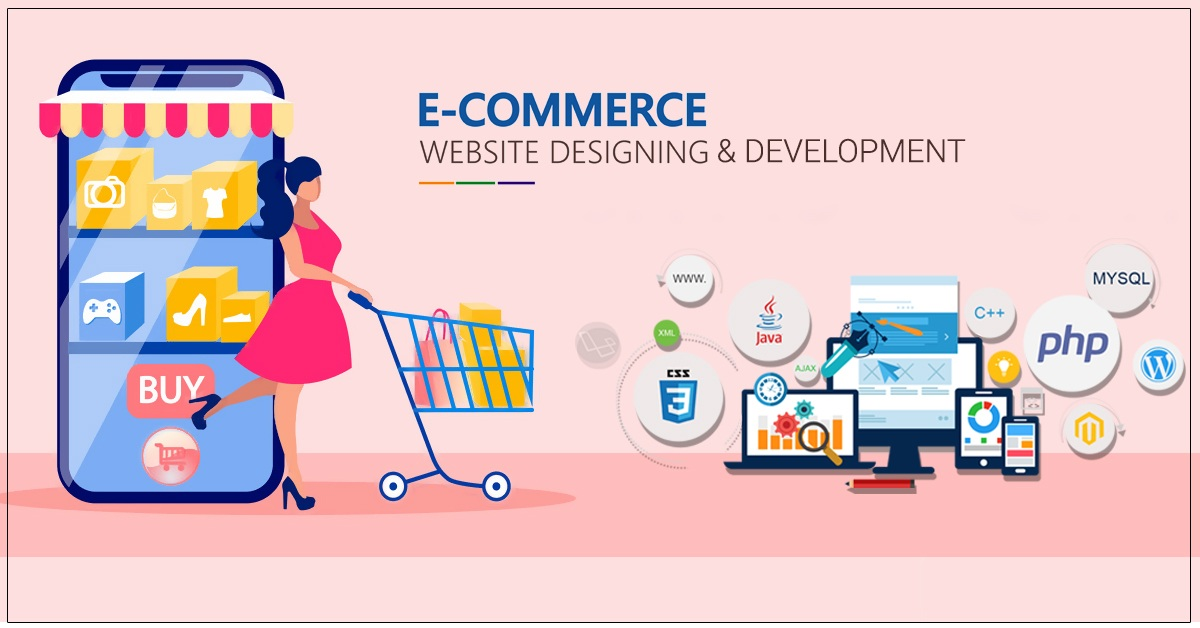A Guide to Web Development for E-commerce Websites
E-commerce websites have become an essential part of business in the digital age. Whether you’re a startup or an established company looking to take your business online, creating a successful e-commerce website is key to reaching your target audience and generating sales. Web development for e-commerce is a unique process that involves building an online store that is functional, user-friendly, secure, and optimized for conversions. This guide outlines the crucial elements you need to consider when developing an e-commerce website.
1. Plan Your Website Structure and Design
Before diving into the technical aspects of e-commerce web development, it’s essential to plan your website’s structure and design. A clean, intuitive design can make a significant impact on user experience, influencing how customers interact with your store.
Key Considerations:
- User Experience (UX): The design should be clean, easy to navigate, and simple. Organize your product categories logically, making it easy for users to find what they’re looking for.
- Mobile Responsiveness: With increasing numbers of customers shopping via mobile devices, your e-commerce site must be mobile-friendly. Ensure your website adapts seamlessly to different screen sizes and devices.
- Branding: The design should align with your brand identity. Use colors, logos, and fonts that resonate with your target audience and create a memorable experience.
2. Choose the Right E-Commerce Platform
One of the most important decisions you’ll make is choosing the e-commerce platform for your website. This decision will influence the website’s functionality, scalability, and ease of use. There are various e-commerce platforms to choose from, each with its pros and cons.
Popular E-Commerce Platforms:
- Shopify: A user-friendly platform that allows you to create an online store quickly with various customization options. Ideal for small to medium-sized businesses.
- WooCommerce: A WordPress plugin that turns a WordPress website into a fully functional e-commerce store. It offers flexibility and control, but may require technical knowledge to set up.
- BigCommerce: A highly scalable platform that offers more advanced features, making it suitable for businesses with complex needs.
- Magento: A robust open-source platform for large businesses with high customizability. It requires technical expertise to manage but is ideal for complex, enterprise-level stores.
Key Features to Consider:
- Payment gateways (PayPal, Stripe, etc.)
- Shopping cart functionality
- Inventory management
- Shipping options
- Product variations (sizes, colors, etc.)
- Customer management
3. Prioritize Security Features
Security is paramount for e-commerce websites. When handling customer data, including sensitive payment information, ensuring a secure browsing and shopping experience is essential to building trust and keeping customers safe. Failure to secure your site can result in data breaches, lost revenue, and a damaged reputation.

Essential Security Features:
- SSL Certificates: Secure Sockets Layer (SSL) encryption ensures that data transmitted between your customers and your website is secure. It’s essential for processing payments and protecting customer information.
- PCI Compliance: If you are processing credit card transactions, you must adhere to the Payment Card Industry Data Security Standards (PCI DSS) to protect cardholder data.
- Two-Factor Authentication (2FA): Use 2FA for administrative accounts to prevent unauthorized access.
4. Implement Seamless Payment Gateways
A smooth and secure payment process is critical for the success of your e-commerce store. Customers need to feel confident that their payment information is safe and that the checkout process is seamless. Your e-commerce website should support multiple payment methods to cater to various customer preferences.
Popular Payment Gateways:
- PayPal
- Stripe
- Square
- Apple Pay
- Google Pay
- Cryptocurrency (optional)
The checkout process should be simple, reducing the number of steps required to complete a purchase. Consider offering guest checkout options to avoid forcing users to create accounts before completing their purchase.
5. Optimize for Search Engines (SEO)
Search engine optimization (SEO) is essential for getting your e-commerce website noticed by search engines like Google. If your website isn’t optimized, potential customers may never find your products. SEO for e-commerce is more than just about product descriptions; it involves optimizing various elements of your website to increase visibility and attract organic traffic.
Key SEO Factors for E-Commerce Websites:
- Product Descriptions: Ensure each product has a unique, detailed description that includes relevant keywords.
- Meta Tags: Optimize title tags, meta descriptions, and image alt texts with relevant keywords.
- URL Structure: Use clean, descriptive URLs for product pages (e.g.,
yourstore.com/product-category/product-name). - Site Speed: Fast-loading websites rank better on search engines and provide a better user experience.
- Mobile Optimization: Google uses mobile-first indexing, so your site must be optimized for mobile devices.
6. Focus on Performance and Speed
Website speed is a major factor in both user experience and SEO. Slow-loading websites can lead to high bounce rates, lost sales, and lower search engine rankings. Optimizing your site’s performance ensures that customers have a smooth, fast experience when browsing your products.
Performance Optimization Tips:
- Compress Images: Large images slow down page load times. Use image compression tools to reduce file sizes without sacrificing quality.
- Use Content Delivery Networks (CDNs): CDNs distribute content across various servers worldwide, improving website speed by reducing latency.
- Enable Caching: Implement caching to store static resources (such as images and CSS files) on users’ devices, reducing load times for repeat visitors.
7. Implement Robust Analytics and Reporting
To optimize your e-commerce store, you need to understand how customers are interacting with your site. Analytics tools provide invaluable insights into customer behavior, helping you make informed decisions about inventory, marketing, and sales strategies.
Essential Analytics Tools:
- Google Analytics: Track user behavior, traffic sources, and e-commerce transactions.
- Heatmaps: Visual tools that show where users are clicking on your site, helping to optimize page layouts.
- Conversion Tracking: Monitor how many users complete a purchase or take other desired actions.
These insights can help you fine-tune your website and marketing efforts, leading to higher conversion rates and more sales.
8. Provide Excellent Customer Support
Finally, excellent customer support is essential for any successful e-commerce website. Whether through live chat, email support, or a comprehensive FAQ section, providing quick and effective customer service can lead to higher customer satisfaction and loyalty.
Support Options to Consider:
- Live Chat: Real-time communication with customers can answer their questions and reduce abandoned carts.
- Help Center/FAQs: A self-service option that helps customers find answers to common questions without needing to contact support.
- Return/Refund Policy: Clearly explain your return, exchange, and refund policies to minimize confusion and potential disputes.
Conclusion
Building an e-commerce website requires careful planning and attention to detail. By focusing on essential elements such as design, security, payment gateways, SEO, and customer support, you can create an online store that attracts and retains customers. E-commerce web development is an ongoing process, so make sure to regularly optimize your website for performance, usability, and security to keep up with changing trends and technologies.
With the right approach, your e-commerce website will not only meet your business goals but also provide a seamless and enjoyable shopping experience for your customers.



